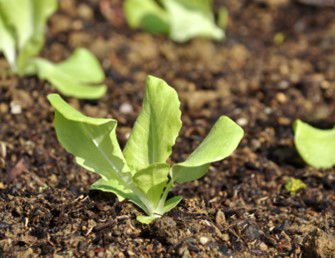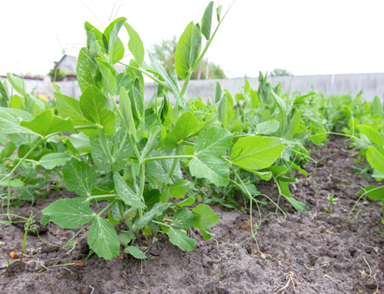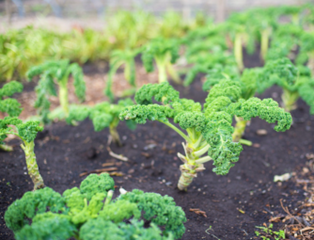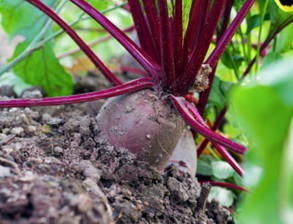(Hint: they're not tomatoes)
Guest Contributor: Cassey Anderson, Horticulture Agent, Colorado State University Extension

It’s finally time to get some plants in the ground for many of us! Now I know that tomatoes are an often requested food donation item, and a favorite of gardeners everywhere, but let’s be honest, they’re princesses and can be difficult to have success with; they can succumb to a myriad of diseases, they can be finicky about cold, fuss about too much heat, too little fertilizer, too much fertilizer, the list goes on. If you’re a first time gardener planning to donate, or if you have had garden struggles in the past few years, try these eight easy plants to grow. If you grow carefully, you can have ample harvests both for your own household, and enough left over to donate.

Lettuce (cool season)
Lettuce is a great starter vegetable crop because the seeds germinate very easily provided they get some moisture, some warmth, and some light. Sow seeds shallow (just a skiff of soil over the top) either indoors or out. Harvest can begin as soon as the seedlings pop up if you’re looking for microgreens, as true leaves form for baby greens, or you can thin the crop and harvest heads after 3-4 weeks. Lettuce does need rich soil that stays moist but drains well and benefits from regular feeds or rich soil.

Radish (cool season)
Radish is probably the best starter crop for vegetable production. It has large, easily manageable seeds that germinate readily and easily, and you can get an edible crop within just a matter of weeks. Be sure to grow in a rich soil or fertilize regularly and grow with ample water to reduce hot and spiky flavors. Radish is a great candidate for succession sowing, which means you plant approximately the amount you’d like to harvest in a week, and then plant another round in 1-3 weeks.
Note: some people do like to plant radish and carrot together. This can help carrots break through the crust of the soil layer (an issue which makes carrots a slightly more challenging crop). Radishes will be ready for harvest long before the carrots, so they don’t compete.

Green Beans pole vs. bush (warm season)
Green beans are a satisfying vegetable garden crop. The seeds are large and germinate readily in warmer soils (50-60 F), often around mid-to late-May. There are two types of beans to look out for and you can select them according to your harvesting preferences. Bush beans do not require support and can be easier on the front end to grow. They will produce 2-3 main crops of beans to harvest and then are done for the season. You can succession sow bush beans to ensure consistent harvesting through the season. Pole beans will require a vertical trellis or support system (see picture) to ensure continued production and they will yield continuously through the growing season if they remain picked. If too many beans begin to mature the plant will slow down production. Beans do not need much supplemental fertilizer as they are able to fix Nitrogen from the air for their own use. This Nitrogen will be released back into the soil in the following season for a new crop to use.

Peas (cool season)
Peas are a satisfying early season crop. These can be planted as soon as the soil can be worked in the spring, and the earlier you plant the better the harvest you’re likely to get. For example, a pea planted April 1st will produce more than a pea planted May 1st. Most peas are bush type and self-supporting but read your label carefully to determine if it is a pole type that needs support structures. Peas are also nitrogen fixers and able to provide their own nutrition. If you have never planted peas in your garden before it could be worth using a pea inoculant called Rhizobia, which can be purchased online or at local garden centers. Inoculate your peas by mixing the seeds with the pea inoculant in the seed packet and shake prior to planting. A second crop of peas can be planted easily in July for a fall harvest.


Kale (cool season)
Kale is another leafy green that is easy to grow and such a great crop you can eat at any maturity size. If you plan to grow to maturity, it’s a good idea to space the seeds sufficiently apart, up to 24” for larger types. Kale can be harvested several times if you only take the mature outer leaves (see picture example). Kale is a cool season plant so grow in spring and plant again in July or August for a fall harvest. Kale will benefit from cool and even cold weather, cold snaps down to 28 degrees F can stimulate a sweeter taste.

Swiss Chard (cool into warm season)
Chard is a great, and easy way to add color into your leafy green offerings. Mature plants can be large so space appropriately (up to 12-18”). You can harvest chard like kale, leaving the smaller, inner leaves to grow more. Swiss chard is related to beets, so every part is edible. Swiss chard may be a good alternative to spinach which can be a little more finicky to grow in the vegetable garden. Chard can be direct sown once the risk of hard frost has passed but can also be transplanted if you want a jump on the season.

Beet (cool into warm season)
Beets are a great way to get those pounds in for donation. They germinate easily and you get a multi-use product as both the root and the leaves are edible. Beet seeds are compound, so spacing carefully will not give you ideal spacing as there are multiple seeds in a cluster. Instead, plant with care, and a few weeks after germination thin to about 3” per plant. Save the seedlings you thinned out and rinse for an addition to a tasty stir fry. For friends who don’t like the “earthy” flavor of beets try a variety like Avalanche, all the sweet with less of the earth. Beets will need to be fertilized a couple of times in the season and need regular watering to prevent splitting. Harvest at about 2.5-3” in diameter, as once they get larger, they can get woody.

Cucumber (warm season)
Cucumbers grow readily and easily either by seed or by purchased seedling. If you do purchase a seedling, try to find one that is small with only a few “true” leaves, or you can plant once soil temperatures reach about 60 degrees and all risk of frost has passed. If planting by seed, it can be wise to plant 2-3 seeds in a planting hole and thin out to one plant once they have germinated. Cucumbers have both male and female flowers, so if you’re getting fruit in the first few weeks of flowering, check to see if you have mini “cucumbers” (see picture for a great example prior to flower maturity) at the base of the flower, or just a stem. Plants typically have male flowers before they have female flowers.

Now this list is by no means exhaustive, and with care and consideration tomatoes, peppers, potatoes, eggplant, squash etc. can be excellent and highly recommended additions to your vegetable garden, they just aren’t as simple to grow as those listed above.
As always, reach out to your local Extension office with additional questions and for further resources. Happy Gardening!

Gardening in Colorado? Check out Grow & Give www.growandgivecolorado.org and in particular our Colorado Vegetable Guide https://growgive.extension.colostate.edu/colorado-vegetable-guide/ for more crop information on all of the above plants.
What if every gardener planted just one extra plant to share?
One small donation can have a tremendous impact. Just imagine, if every gardener planted one extra plant to share, collectively, we would have an abundant source of fresh, healthy produce available to be distributed to families experiencing food insecurity in our own communities! The free Fresh Food Connect mobile app connects you to a local hunger relief program, then manages and tracks your donations of homegrown produce throughout the season. Download the app today!